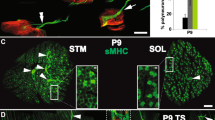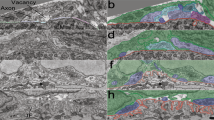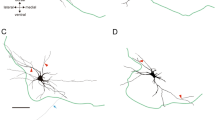Abstract
In developing mammalian muscle, axon branches of several motor neurons co-innervate the same muscle fibre. Competition among them results in the strengthening of one and the withdrawal of the rest1,2. It is not known why one particular axon branch survives or why some competitions resolve sooner than others3. Here we show that the fate of axonal branches is strictly related to the identity of the axons with which they compete. When two neurons co-innervate multiple target cells, the losing axon branches in each contest belong to the same neuron and are at nearly the same stage of withdrawal. The axonal arbor of one neuron engages in multiple sets of competitions simultaneously. Each set proceeds at a different rate and heads towards a common outcome based on the identity of the competitor. Competitive vigour at each of these sets of local competitions depends on a globally distributed resource: neurons with larger arborizations are at a competitive disadvantage when confronting neurons with smaller arborizations. An accompanying paper tests the idea that the amount of neurotransmitter released is this global resource4.
This is a preview of subscription content, access via your institution
Access options
Subscribe to this journal
Receive 51 print issues and online access
$199.00 per year
only $3.90 per issue
Buy this article
- Purchase on Springer Link
- Instant access to full article PDF
Prices may be subject to local taxes which are calculated during checkout




Similar content being viewed by others
References
Purves, D. & Lichtman, J. W. Elimination of synapses in the developing nervous system. Science 210, 153–157 (1980)
Wong, R. O. L. & Lichtman, J. W. in Fundamental Neuroscience (ed. Squire, L. et al.) 533–553 (Academic, San Diego, 2003)
Keller-Peck, C. R. et al. Asynchronous synapse elimination in neonatal motor units: studies using GFP transgenic mice. Neuron 31, 381–394 (2001)
Buffelli, M. et al. Genetic evidence that relative synaptic efficacy biases the outcome of synaptic competition. Nature, this issue (2003)
Lichtman, J. W. The reorganization of synaptic connexions in the rat submandibular ganglion during post-natal development. J. Physiol. (Lond.) 273, 155–177 (1977)
Colman, H., Nabekura, J. & Lichtman, J. W. Alterations in synaptic strength preceding axon withdrawal. Science 275, 356–361 (1997)
Chen, C. & Regehr, W. G. Developmental remodeling of the retinogeniculate synapse. Neuron 28, 955–966 (2000)
Brown, M. C., Jansen, J. K. & Van Essen, D. C. Polyneural innervation of skeletal muscle in newborn rats and its elimination during maturation. J. Physiol. (Lond.) 261, 387–422 (1976)
Jansen, J. K. & Fladby, T. The perinatal reorganization of the innervation of skeletal muscle in mammals. Prog. Neurobiol. 34, 39–90 (1990)
Sanes, J. R. & Lichtman, J. W. Development of the vertebrate neuromuscular junction. Annu. Rev. Neurosci. 22, 389–442 (1999)
Feng, G. et al. Imaging neuronal subsets in transgenic mice expressing multiple spectral variants of GFP. Neuron 28, 41–51 (2000)
Press, W. H., Teukolsky, S. A., Vetterling, W. T. & Flannery, B. P. Numerical Recipes in C (Cambridge Univ. Press, 1992)
Gan, W. B. & Lichtman, J. W. Synaptic segregation at the developing neuromuscular junction. Science 282, 1508–1511 (1998)
Personius, K. E. & Balice-Gordon, R. J. Activity-dependent editing of neuromuscular synaptic connections. Brain Res. Bull. 53, 513–522 (2000)
Balice-Gordon, R. J. & Lichtman, J. W. Long-term synapse loss induced by focal blockade of postsynaptic receptors. Nature 372, 519–524 (1994)
Buffelli, M., Busetto, G., Cangiano, L. & Cangiano, A. Perinatal switch from synchronous to asynchronous activity of motoneurons: link with synapse elimination. Proc. Natl Acad. Sci. USA 99, 13200–13205 (2002)
Personius, K. E. & Balice-Gordon, R. J. Loss of correlated motor neuron activity during synaptic competition at developing neuromuscular synapses. Neuron 31, 395–408 (2001)
Barber, M. J. & Lichtman, J. W. Activity-driven synapse elimination leads paradoxically to domination by inactive neurons. J. Neurosci. 19, 9975–9985 (1999)
Walsh, M. K. & Lichtman, J. W. In vivo time lapse imaging of synaptic takeover assosciated with naturally occurring synapse elimination. Neuron 37, 1–7 (2003)
Acknowledgements
We thank the members of our laboratory and J. R. Sanes for many useful discussions, J. Tollet for help breeding animals, J. D. Wiley for assistance in collecting initial data, and S. Turney for technical advice and developing programs for the statistical tests. We thank J. R. Sanes and G. Feng for generating the original transgenic mice. This work was supported by grants from the National Institutes of Health and the Muscular Dystrophy Association to J.W.L., and by support from the Bakewell Neuroimaging Fund.
Author information
Authors and Affiliations
Corresponding author
Ethics declarations
Competing interests
The authors declare that they have no competing financial interests.
Rights and permissions
About this article
Cite this article
Kasthuri, N., Lichtman, J. The role of neuronal identity in synaptic competition. Nature 424, 426–430 (2003). https://doi.org/10.1038/nature01836
Received:
Accepted:
Issue Date:
DOI: https://doi.org/10.1038/nature01836
This article is cited by
-
Terminal Schwann cell and vacant site mediated synapse elimination at developing neuromuscular junctions
Scientific Reports (2019)
-
VAChT overexpression increases acetylcholine at the synaptic cleft and accelerates aging of neuromuscular junctions
Skeletal Muscle (2016)
-
Neurotransmission selectively regulates synapse formation in parallel circuits in vivo
Nature (2009)
-
A technicolour approach to the connectome
Nature Reviews Neuroscience (2008)
-
Transgenic strategies for combinatorial expression of fluorescent proteins in the nervous system
Nature (2007)
Comments
By submitting a comment you agree to abide by our Terms and Community Guidelines. If you find something abusive or that does not comply with our terms or guidelines please flag it as inappropriate.



